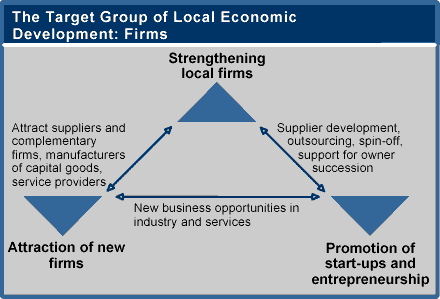First triangle: The target group of local economic development: companies
Economic development is based on the efforts of companies – some of them government-owned, but most of the private. The main target group of local economic development (LED) are thus companies, in particular the private sector. Further target groups include the workers and the public sector; we will come to them when we discuss locational factors.
What kind of companies are the main target group? In many cases, LED efforts are mainly directed at external companies. The main goal of traditional LED efforts (i.e. in industrialized countries: from the 1960s to the 1980s) was to attract new investors. It would be much too narrow, however, to leave it at that. Basically, there are three types of firms which can be the target of LED:
- External investors
- Local companies
- Start-up companies
It depends on the features of a given location which of these three types is the priority target. External investors are particularly relevant for locations with a weak local company base and little entrepreneurial dynamism. In locations with a strong local economic base, promoting the competitiveness of existing companies is often much more relevant than attracting firms.
Yet the main message is: Do not conceptualize the three target groups in an either/or manner. Instead, try to realize the synergies between them. The following figure tries to visualize the potential synergies.
Let us have a look at the two arrows linking "strengthening local firms" with the other two activities.
1. When trying to attract external investors, try to attract any kind of firm is one option. But it is not necessarily a promising option. If there already is a local economic base, say in the food processing industry, why would an electronics manufacturer find this location attractive? If there is little if any economic base, why would any external investor find such a place attractive? External investors tend to cluster. So if your location has a profile, like in food processing, you would be well advised to try to attract complementary investors.
How can you do that? The most promising approach is to consult with local firms. They are the experts on their industry, they know the players in the industry, and therefore they are in a privileged position when it comes to identifying potential investors. The main objective is to identify firms which may strengthen the local profile, in particular in terms of providing specialized inputs, services, and capital goods. You will also find that you can "sell" your location much easier to an external investor who finds a strong local demand for his products or services.
2. Regarding promotion of start-ups, it is important to note that this can be closely linked with the existing economic base. Existing firms may want to outsource certain activities, but cannot find adequate subcontractors. Training new entrepreneurs or underperforming businesspeople is a possible approach to improve the conditions for local subcontracting, thus at the same time increasing the competitiveness of lead firms and creating opportunities for new businesses. Another approach is the support for spin-offs. Professionals in existing firms may consider to set up their own shops to produce specific inputs or provide services to their current employer, but hesitate to actually do so since they feel insufficiently prepared. Again, targeted training courses may be an option.
On the following pages, we will have a look at specific instruments related to this triangle:
the target group
![]()
![]() SME
support
SME
support
![]() SME promo-
SME promo-
![]() tion
tion
![]() investment
investment
![]() promotion
promotion
![]() entrepreneur-
entrepreneur-
![]() ship
ship
![]() promotion
promotion
